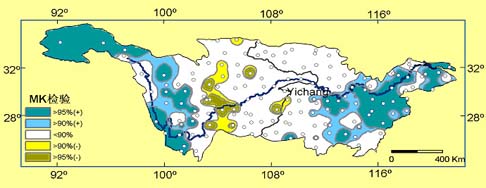

Areas with more rainstorm-hit days in the Yangtze Valley
As a result of the global warming, more rapid water cycles and uneven precipitation, the number of precipitation extremes in the Yangtze valley has kept increasing over the past four decades, revealed researchers of a five-year CAS project on floods-causing environment in the middle and lower reaches of the Yangtze Valley. They also expected more flooding disasters in the coming years in a case the observed trends of the last 40 years prevail into the future.
The discovery was made by a research team headed by Prof. Jiang Tong from the CAS Nanjing Institute of Geography and Limnology on the basis of an analysis of temporal and spatial distribution characteristics of precipitation extremes in the Yangtze valley by using daily precipitation data from 147 stations in the valley during the period from 1960 to 2003. Their work was published in the June issue of Hydrological Sciences Journal.
The researchers found that the annual precipitation has shown a rising trend in much of the valley over the 44 years. In the whole valley, the summer precipitation saw a drastic rise. Since the 1990s, in particular, the situation is even worse as much of the valley was hit by more rainstorms in terms of the number of raining days. In the context, no remarkable change in the local hydrological regimen occurred in the river's upper reaches while a sharp rise made its appearance in both the summer runoff amount and highest flooding peak value in middle and lower reaches of the river. In the latest decade, the increased numbers of rainstorm-hit days in the summer were found to be concentrated in the southwest China (in the Jinshajiang, one of the largest tributaries of the Yangtze) and the low-lying areas in central China (in the basins of the Lake Dongting and Lake Poyang), including the fertile southern Jiangsu Province where the Lake Taihu is located. Without doubts, the increase of the summer precipitation volume, and the numerical increase of the summer days hit by rainstorms in particular, will enhance the risk of more floods in the valley's lower reaches.
From the research data, the scientists discovered that, the Yangtze's upper reaches, Sichuan Basin and the peripheries of the Lake Dongting and Lake Poyang were the most vulnerable areas with highest frequencies of extreme precipitation event (EPEs). Now the region presents a reducing tendency when reviewed at the direction from the southeast to northwest while the areas adjacent to the two lakes were the sites most frequently hit by rainstorms in summer.
During the past 44 years, the earlier two decades had seen a dropping trend in the EPEs. But since the 1990s, a reverse trend has been coming into being with higher and higher concentration rates registered in the valley. Seen from a long run, 63.3% of the summer precipitation increase were brought in by rainstorms in the Yangtze's middle and lower reaches while in the upper reaches with less precipitation, the same figure was 58.5%. Meanwhile, the frequency of EPEs lasting 1-5 days in a row saw a steady rise. Such events accounted for more than 60% of the increment in total volume of annual precipitation. So the extreme events are becoming more concentrated in short periods.
Besides, a statistical analysis of the on-going trend shows that, the concentration degree of the EPE events in June sees a dramatic rise in the upper reaches of the Yangtze. Before the 1990s, the torrential rains had been always appearing in July or August in the upper reaches while the plum rains basically came to an end in the middle and lower reaches. So, the incoming water from the upper reaches made its way into the sea smoothly along the Yangtze mainstream, imposing nothing serious to the anti-flooding embankments in the Yangtze delta. By now, however, the rainy season in the upper reaches is to come in June and at this moment, the middle and lower reaches are being hit by strong downpours as the plum rains arrive in time. As a result, the changed situation multiplies the risk of possible floods or inundation threats in the low-lying areas of the middle and lower reaches. Hence, the anti-flood defense along the river's mainstream becomes more menaced as shown in a similar situation of the 1998 deluge which took place in the valley, leading to a disastrous aftermath.
The summer floods in the Yangtze, as shown by the research project, were always triggered by a sustained and steady spell of massive precipitation during the 1950s and 1960s. But since the 1990s, they have been caused mostly by powerful rainfalls in a short duration as a result of the global warming-up. Hence, the possibility of more deluges to hit the valley is increasing, leading to aggravated threats of the Yangtze floods and more difficulties are expected for the anti-flood campaigns in the near future.






